Write to Read Group Presents to Nova Scotia Virtual Conference
Friday, October 22, 2021 — 11:00 am Pacific Time
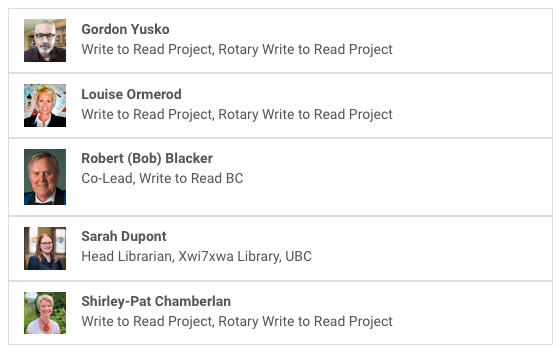
Literacy, Learning and Life in Indigenous Communities Through Libraries and Learning Centres
Friday, October 22, 2021 — 11:00 am Pacific Time

Literacy, Learning and Life in Indigenous Communities Through Libraries and Learning Centres

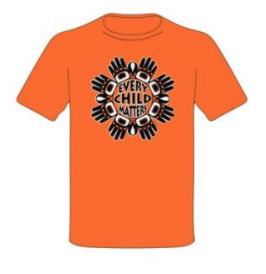
Read the Latest
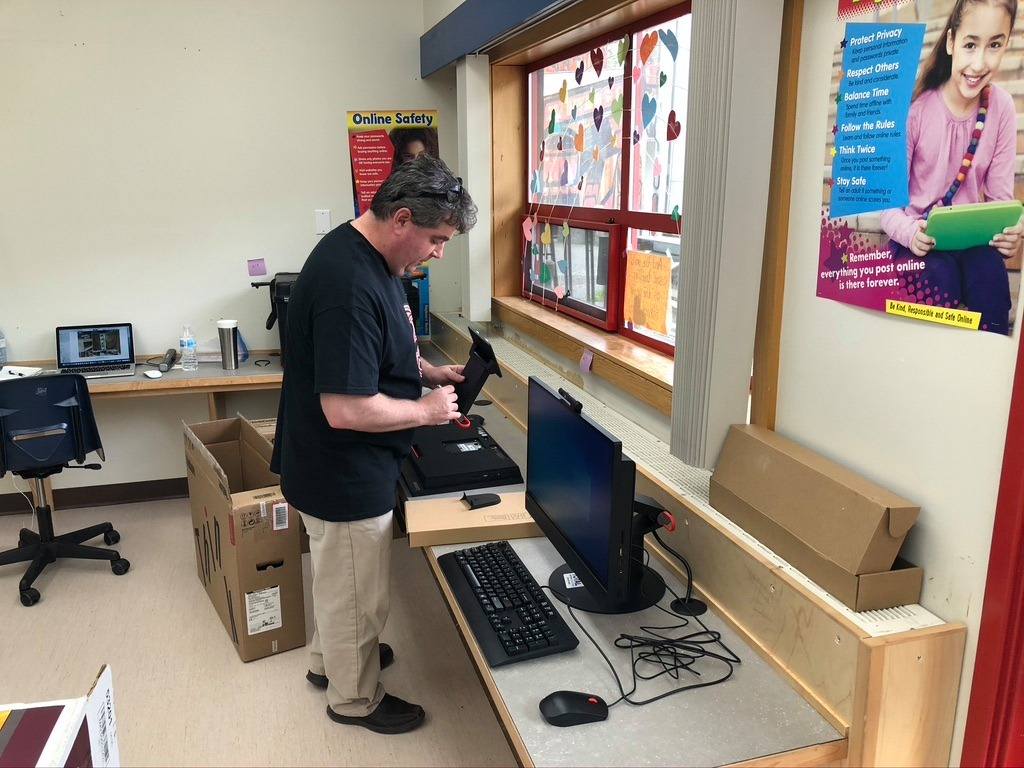
AFTER A LONG WINTER AND NOW THE PANDEMIC W2R IS STARTING TO GET ORGANIZED FOR OUR NEXT INSTALS.Yes I am happy to say that today I was able to get over to Nanaimo to look at our storage facility ULOCK STORAGE to organize our shelving for our upcoming 5 instals. This has been a long time coming. Our communities have now given us the green light to come into their nation so stay tuned for some amazing instals that will be happening.The visit today is also to speak with our friends at the Nanaimo Correctional Centre to plan our future furniture builds. It is truly amazing what they have done for W2R.Just for a chuckle here I am with my COVID19 haircut (none since Jan 2020) and will not be cut until the pandemic is over lol.
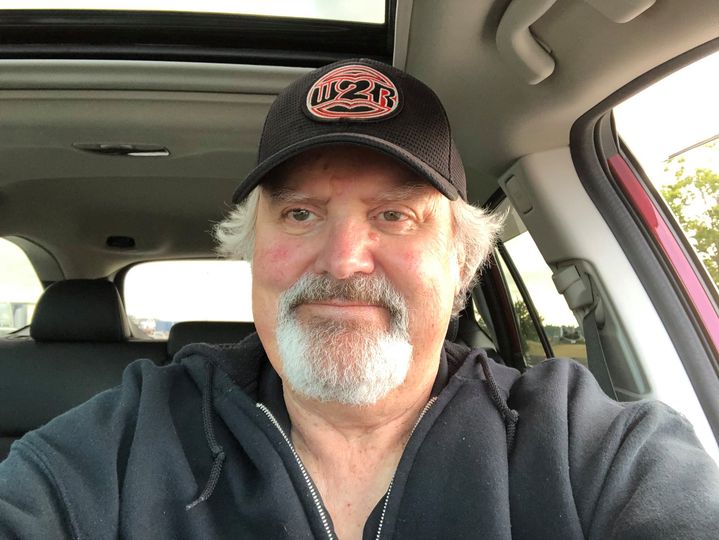
MISSION ACCOMPLISHED!W2R Lockers at NANAIMO ULOCK ARE FULL and we have been given the green light from our waiting communities which means we now can get moving. First off the line will be Aboriginal Mothers Care Centre in the Downtown Eastside of Vancouver, followed by GITSEGUKLA located on Highway 16 near New Hazleton BC, Littlest People Elementary School Capilano reserve, and completion of Little Chiefs Elementary School library – Williams Lake FN and the Learning Centre at TSIDELDEL FN Chilcotin. It is going to be a busy few months….. stay tuned.
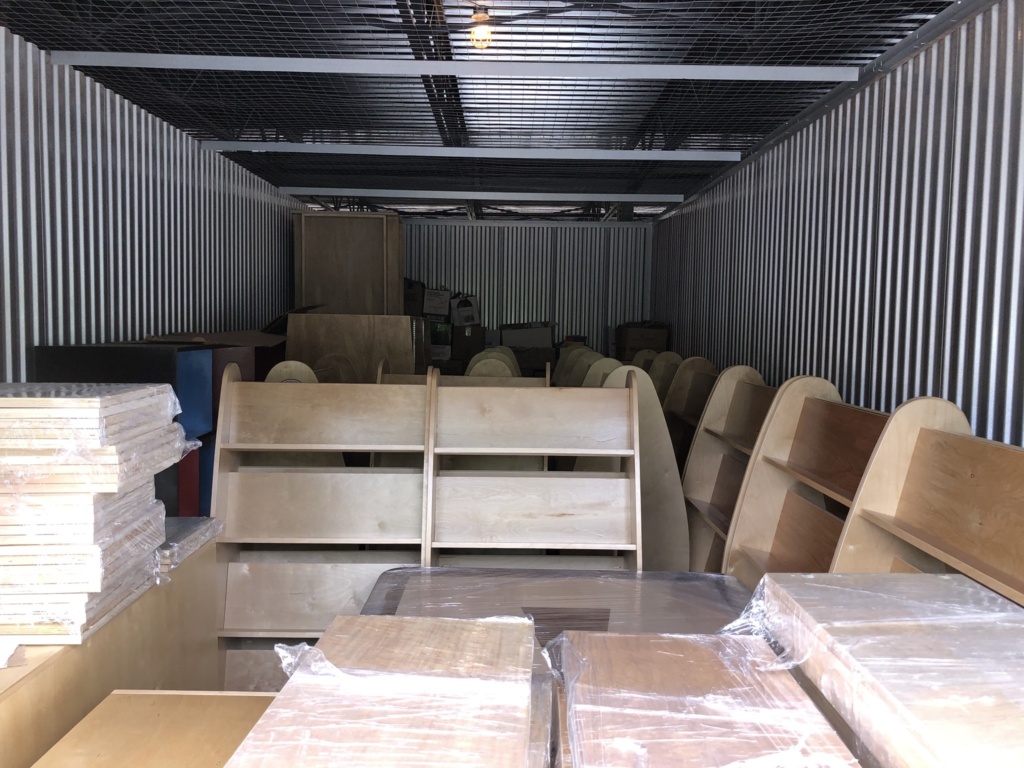
A shining example how a W2R community has used their library. Congratulations to Jess Housty and the BELLA BELLA community…
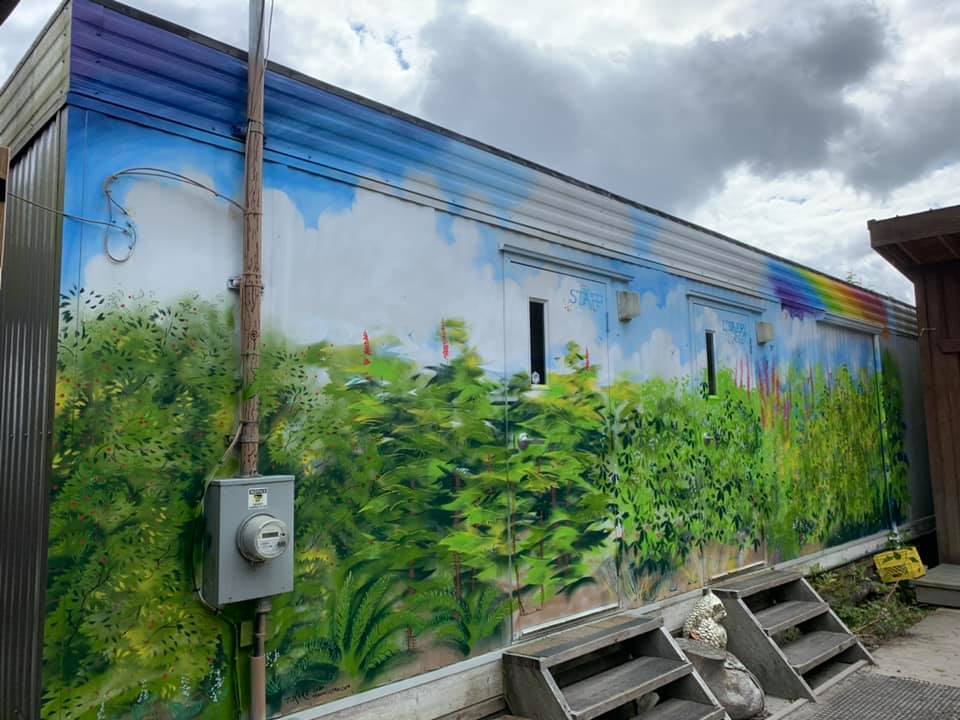
Need to brighten up your cloudy day? Stop by our library/office and check out this beautiful new mural by Thomas Kero! Photos don’t do it justice. There are so many hidden creatures and special features nestled into the summertime foliage. ![]() Find more of Tom’s work here: www.thomaskero.com
Find more of Tom’s work here: www.thomaskero.com
GITSEGUKLA LEARNING CENTRE INSTAL IS NOW FULL STEAM AHEAD….After another long drive from Prince George we arrived in the community about 2.45pm on Tuesday. As usual the LRT’s swung into action with the School staff and Principal Louise Ormerod. Once unloaded the LRT’s started to organize the layout of the learning centre.
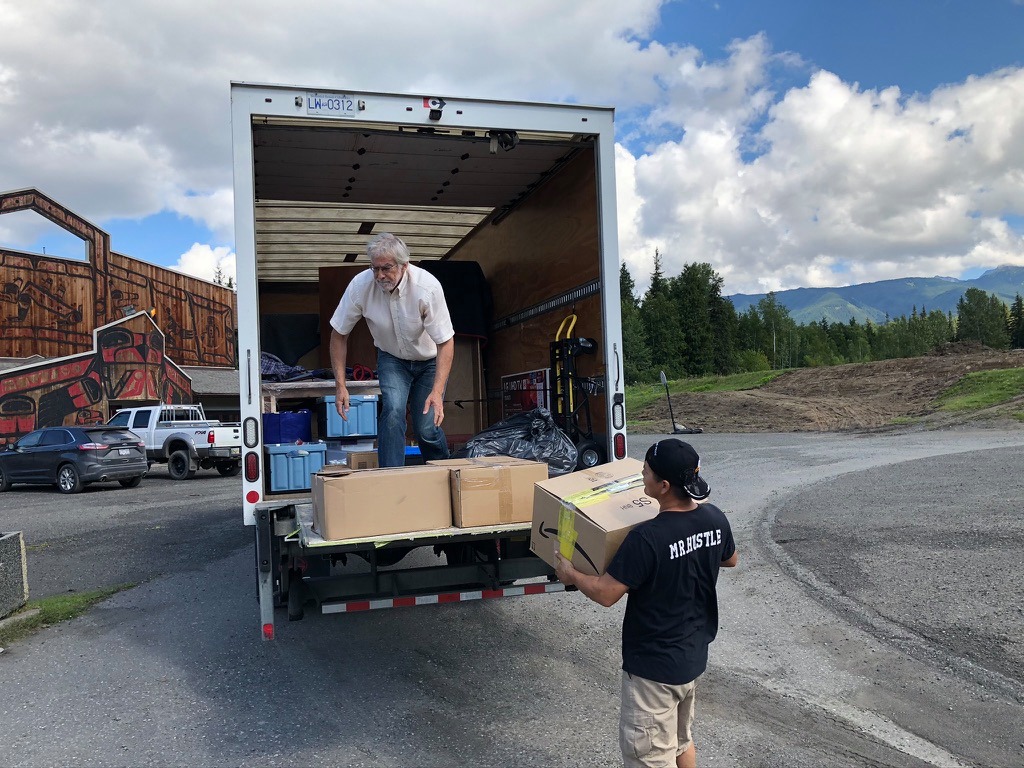
GITSEGUKLA – DAY 1 INSTAL – The team started off early and have been progressing really well. We have already had to go to Terrace – a 3 hr return trip – to get some more shelving tabs plus a HDMI cable for the TV. Chris GILLEN CEO Total Support Services helped us out and did the 3 hour trek!
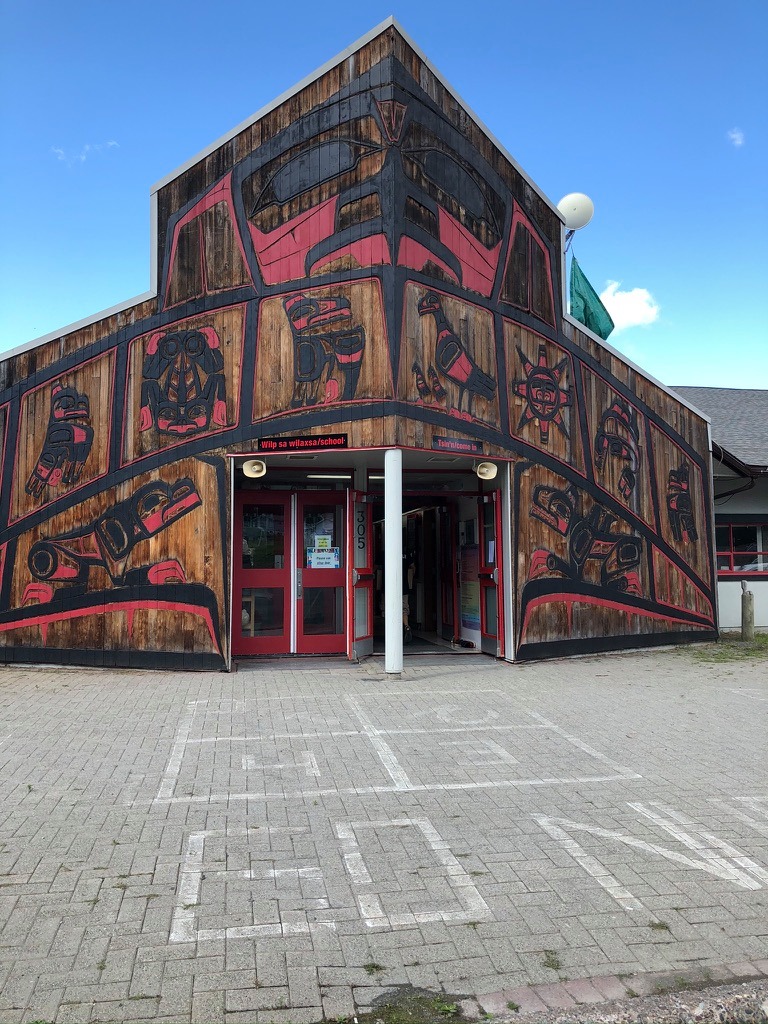
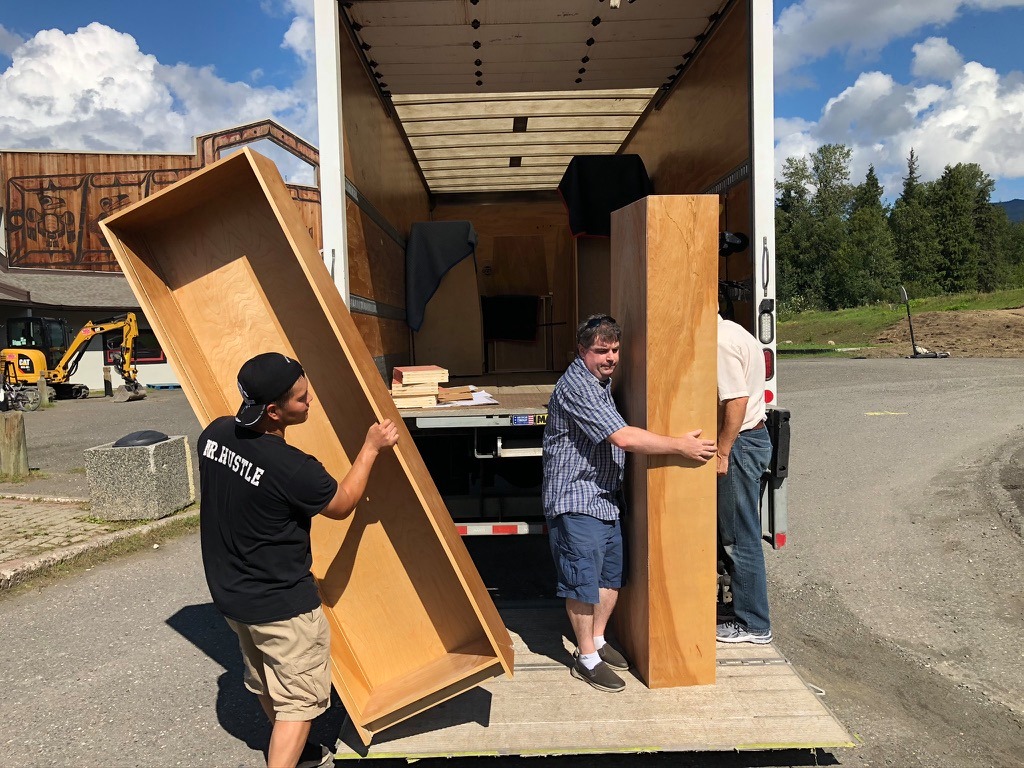
MEET CHRIS GILLEN CEO TOTAL SUPPORT SOLUTIONSWe in W2R have been blessed with great sponsors. Our latest sponsor TOTAL SUPPORT SOLUTIONS came about as a result of a Victoria-Harbourside Rotary Club meeting just a few weeks ago. Bob Blacker was giving a W2R presentation and during that zoom talk connected with one of the members. This member said her son-in-law was working with FN in relation to computers and IT training & solutions. A few days later Bob received a call from Chris GILLEN TOTAL SUPPORT CEO in relation to what W2R was doing and as a result we now has a supplier of computers and all hardware associated with the learning centre installations. In addition TOTAL SUPPORT will at no cost support the computers and look after any problems that may surface with the ability to fix those problems online. This has been huge for us as the support for our computers has always been a concern, now we do not have to worry about that.More impressive to us, CEO Chris joined us on our trip to GITSEGUKLA so he is seeing firsthand how we conduct our instals as well as how we connect with our community…. win win all around!
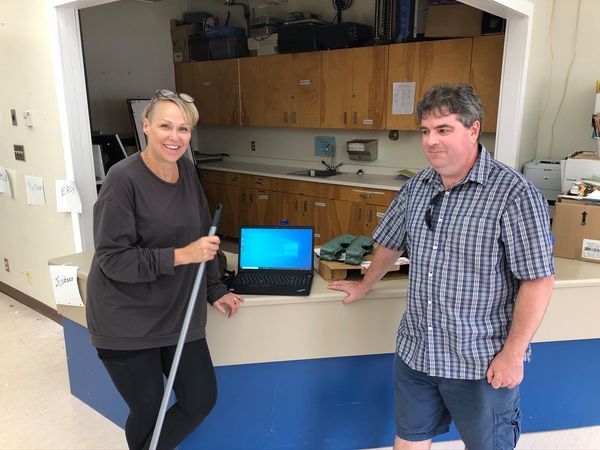
SUPPER & MEETING WITH GITSEGUKLA CHIEF AND COUNCIL.With an amazing setting PRINCESS LAKE our W2R team were able to meet up with Chief Willie and 3 of his council members. This was a great evening that allowed members of the team to chat with key members of the community. The evening ended with a handshake between Chief Willie and Leader of the W2R team Bob Blacker cementing the agreement and the blossoming friendship and trust with GITSEGUKLA. The evening was topped off with a W2R IMAGINEERING SESSION with Scott where those in attendance were in awe of what Scott designed for the community. Our W2R team have never experienced this especially with a Chief and his council members. What our team gained from this exposure was priceless and made their trip a memorable one. As one of the LRT’s said this what makes it all worth it.
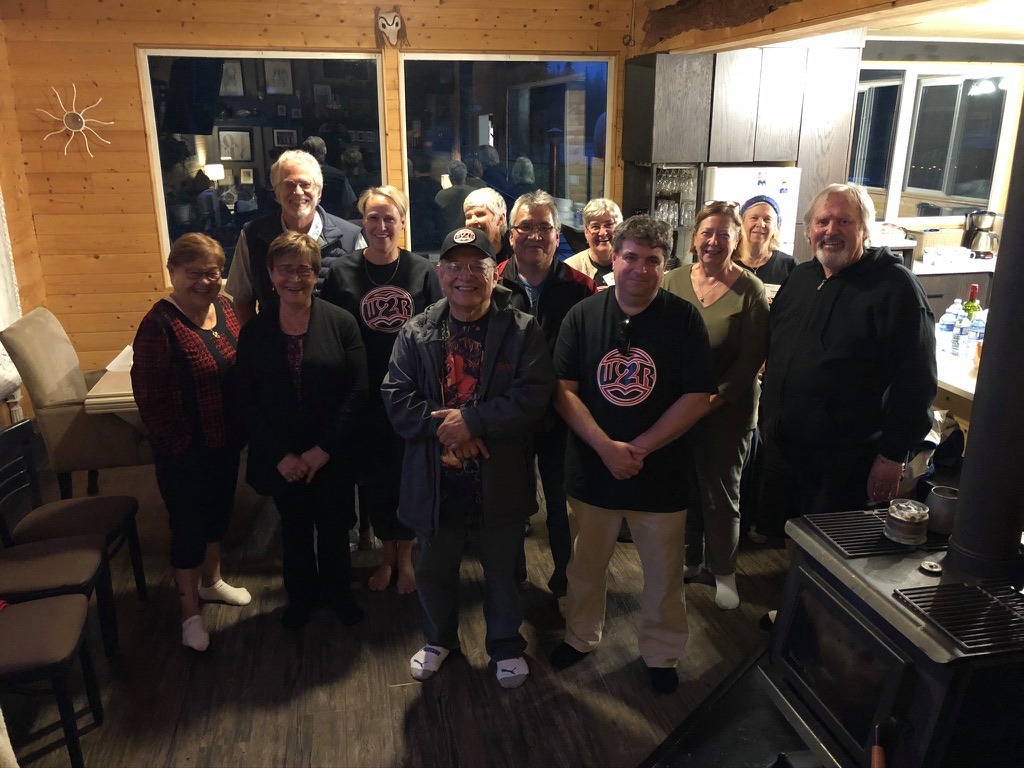
SUPPER & MEETING WITH GITSEGUKLA CHIEF AND COUNCIL.With an amazing setting PRINCESS LAKE our W2R team were able to meet up with Chief Willie and 3 of his council members. This was a great evening that allowed members of the team to chat with key members of the community. The evening ended with a handshake between Chief Willie and Leader of the W2R team Bob Blacker cementing the agreement and the blossoming friendship and trust with GITSEGUKLA. The evening was topped off with a W2R IMAGINEERING SESSION with Scott where those in attendance were in awe of what Scott designed for the community. Our W2R team have never experienced this especially with a Chief and his council members. What our team gained from this exposure was priceless and made their trip a memorable one. As one of the LRT’s said this what makes it all worth it.
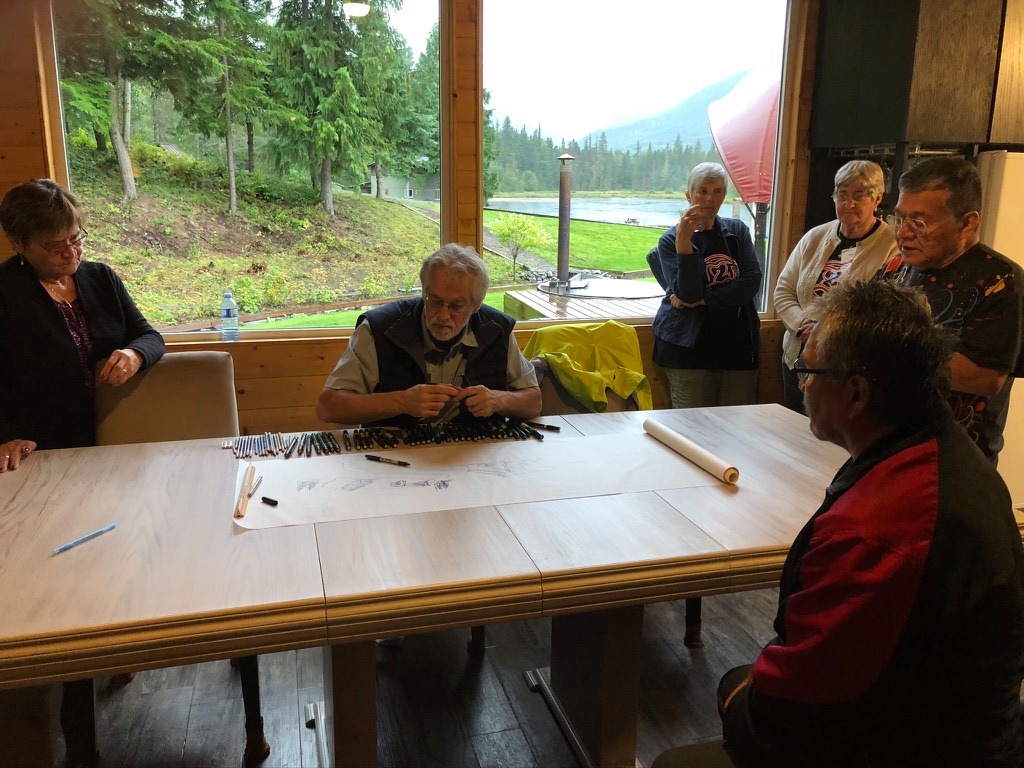
ITS A WRAP – THE GITSEGUKLA W2R V3.0 LEARNING CENTRE IS COMPLETE.After 3 days of hard work the W2R along with Principal Louise Ormerod and her staff have completed W2R’s very first V3.0 learning centre. We had some hiccups but we were able to prevail, the new library/resource centre looks great!
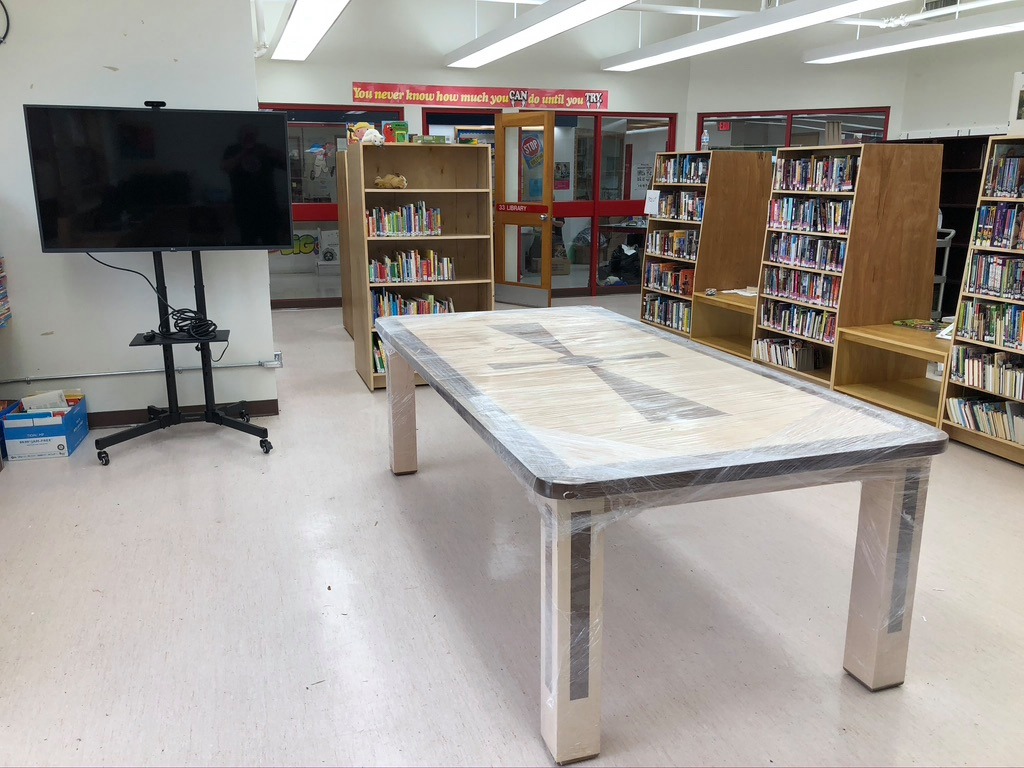
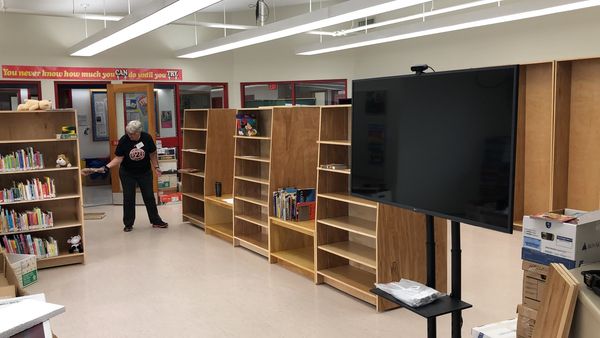
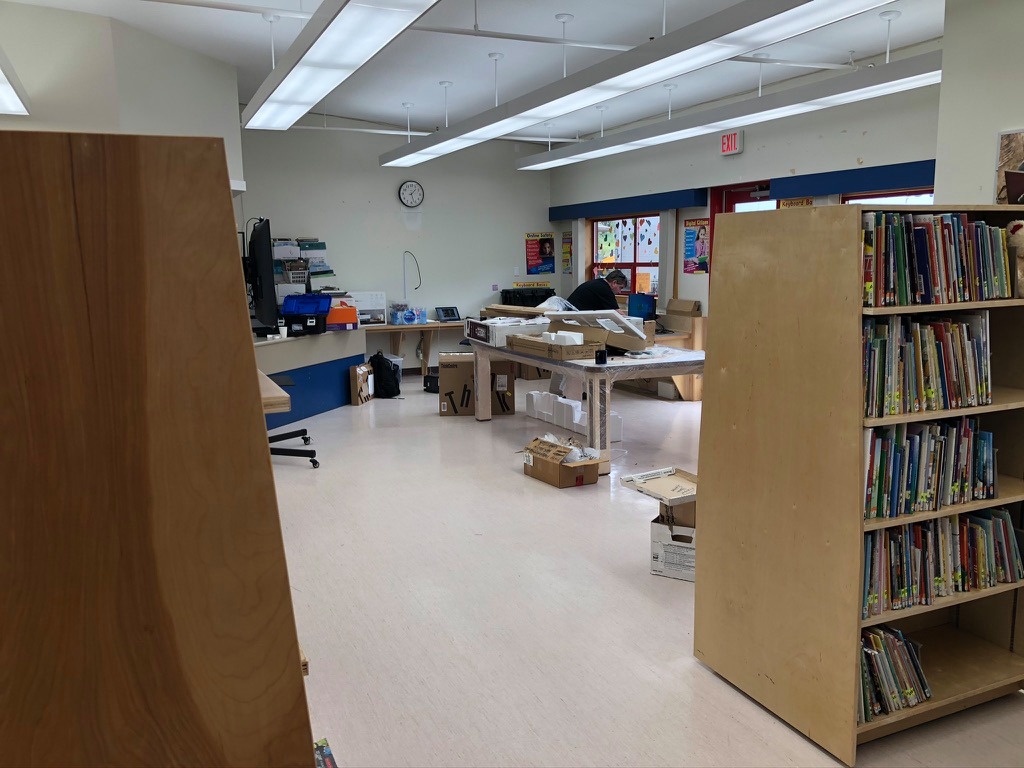
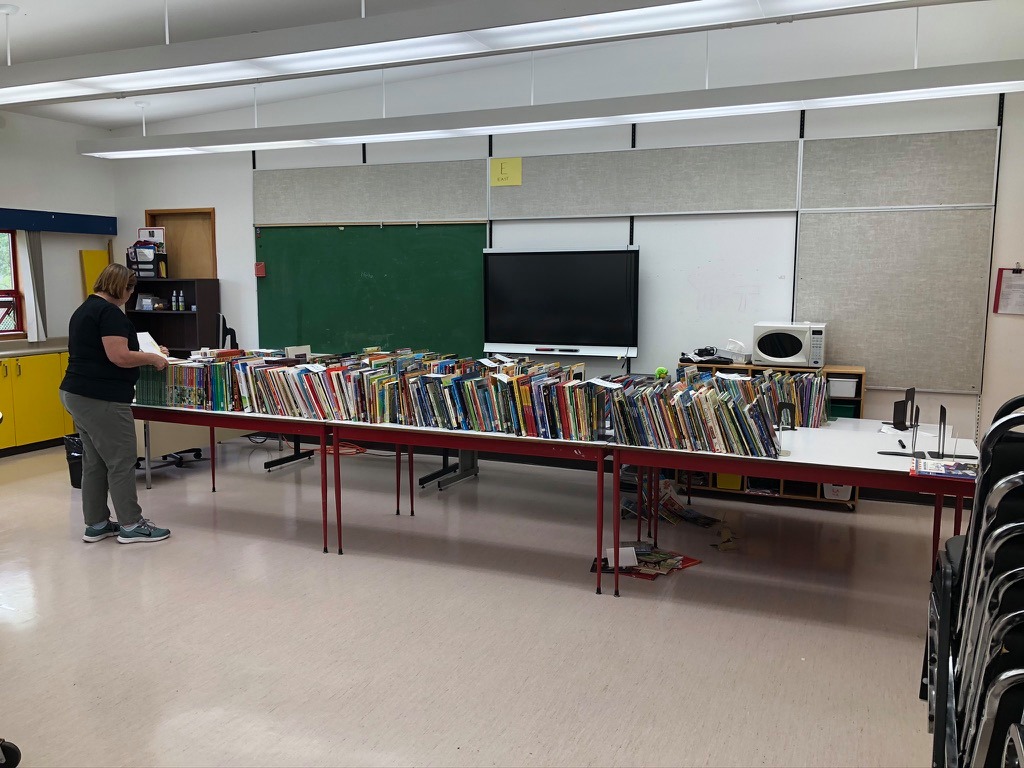
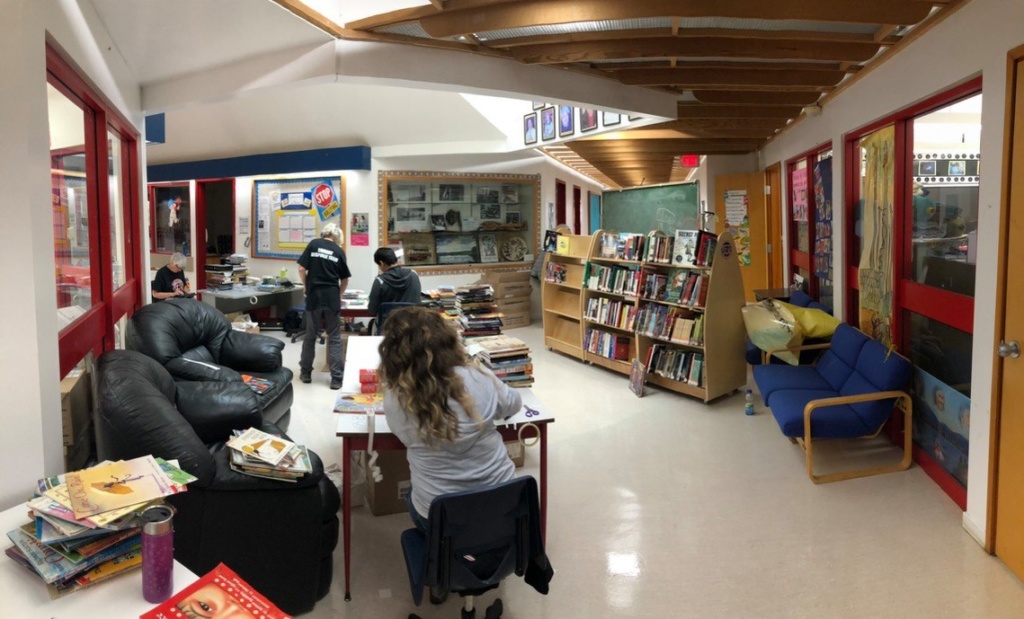
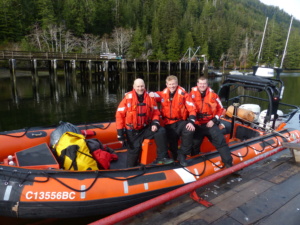
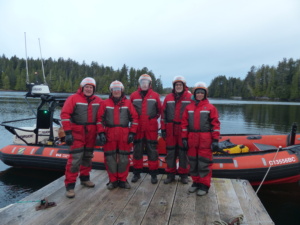
It was one wild ride. You don’t know the definition of “brisk” until you have taken a swift ride aboard a Coast Guard zodiac in the open ocean at 40 knots. They give you survival suits and helmets with face masks for a good reason. You don’t even want to hear the word “rain” as you hunker down with the wind whistling past your face.
The Canadian Coast Guard has been involved with the W2R Project for some time, providing transportation for previous Lt. Governor Steven Point and current Lt Governor Judith Guichon to remote aboriginal settlements along the coast. On a recent W2R team visit to Kyquot, which requires a water taxi between the village and Fair Harbour, the Coast Guard vessel Tanu under the supervision of Captain Bill Bennet was in attendance doing search and rescue training. Several of the ship’s crew offered the W2R team a ride back to Fair Harbour.
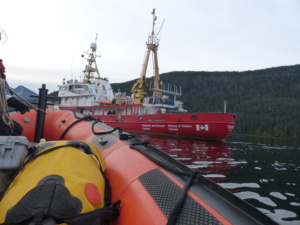 Along the way the W2R team was offered a quick visit onboard the Tanu and to meet the 15-member crew. Search and Rescue is an important aspect of the member’s work. The Tanu maintains close relationships with First Nations along the coast. Often the First Nations communities are the first to react to a sinking or other emergency. When a whale watching vessel sank off Tofino, it was the First Nations skippers who responded first. When the BC Ferries Queen of the North sank near Hartley Bay, it was local villagers who were first on the scene.
Along the way the W2R team was offered a quick visit onboard the Tanu and to meet the 15-member crew. Search and Rescue is an important aspect of the member’s work. The Tanu maintains close relationships with First Nations along the coast. Often the First Nations communities are the first to react to a sinking or other emergency. When a whale watching vessel sank off Tofino, it was the First Nations skippers who responded first. When the BC Ferries Queen of the North sank near Hartley Bay, it was local villagers who were first on the scene.
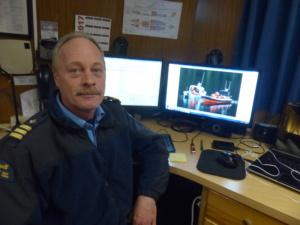 The Coast Guard joins the RCMP, BC Ferries, Britco Structures, Telus, Bandstra, Rotary District 5040, Windsor Plywood, Nanaimo Correctional Centre and numerous small businesses as a member of the Write to Read team.
The Coast Guard joins the RCMP, BC Ferries, Britco Structures, Telus, Bandstra, Rotary District 5040, Windsor Plywood, Nanaimo Correctional Centre and numerous small businesses as a member of the Write to Read team.
Treaty negotiations pass through six stages. HTG currently in Stage four of the process — the Agreement in Principle (AiP) stage.
Stage One: Statement of Intent
A First Nation wanting to initiate treaty negotiations must file a statement of intent with the Treaty Commission. The statement must:
identify the First Nation and its members;
describe the First Nation’s traditional territory;
indicate that the First Nation has a mandate to enter into and represent its members in treaty negotiations; and
appoint a formal contact person.
Stage Two: Preparation for Negotiations
The three parties confirm their commitment to negotiate a treaty, establish that they have the authority and resources to commence negotiations, have a means of developing their mandates and broadly outline what each of them wishes to negotiate.
Stage Two: Readiness Documents
By the end of Stage Two, Canada and BC must also submit readiness documents to the Treaty Commission in which they identify community interests in the region and establish ways to address those interests. The table moves on to Stage Three when the Treaty Commission is satisfied that the parties have met these requirements.
Stage Three: Negotiation of a Framework Agreement
The Framework Agreement defines the issues the parties have agreed to negotiate, establishes the objectives of the negotiation, identifies the procedures that will be followed and sets out a timetable for negotiations. The parties expand their public consultation in local communities and initiate a program of public information.
Stage Four: Negotiation of an Agreement in Principle
Substantive treaty negotiations take place in this stage. Land, resources, self-government and financial components usually form part of the negotiations. The Agreement in Principle sets out the key objectives and elements to be part of the treaty.
Stage Five: Negotiation to Finalize a Treaty
At this stage, outstanding legal and technical issues are resolved. Formal signing and ratification of the agreement brings the parties to Stage Six.
Stage Six: Treaty Implementation
The plans to implement the treaty are put into effect or phased in as agreed. The table remains active to oversee the implementation of the treaty.
If all goes right, the construction project shaping up at Oweekeno (Rivers Inlet) can serve as a blueprint for future partnerships between First Nations people and city folk all across Canada. This project brings together a wide variety of rural and urban groups, companies, government agencies and private individuals all with a common purpose – to build community.
 Oweekeno is located on the banks of the Wannock River at the entrance to Owikeno Lake east of Rivers Inlet, south of Bella Bella on the BC coastline. It’s so small and remote the village is hard to find on a map. Oweekeno is home to the 280 members of the Wuikinuxv Nation, many who live off-reserve in other areas of the province. The Wuikinuxv have an affiliation with the Oweekeno/Kitasoo/Nuxalk Tribal Council in Bella Coola.
Oweekeno is located on the banks of the Wannock River at the entrance to Owikeno Lake east of Rivers Inlet, south of Bella Bella on the BC coastline. It’s so small and remote the village is hard to find on a map. Oweekeno is home to the 280 members of the Wuikinuxv Nation, many who live off-reserve in other areas of the province. The Wuikinuxv have an affiliation with the Oweekeno/Kitasoo/Nuxalk Tribal Council in Bella Coola.
Currently the reserve hosts a band administration office, a health centre, a K-7 school, a fire hall, an airstrip, and a newly constructed ceremonial “Big House” used for cultural purposes. Soon, however, the community will be the proud owner of a new multi-purpose flex court to be used for healthy recreational activities such as basketball, volleyball, ball hockey and tennis. This new facility is a cooperative venture between the rural Wuikinuxv and “city folks” organized under the direction of Rotarian Bob Blacker, former Regional Governor of Rotary District 5040, currently working in conjunction with His Honour Stephen Point, the Lt. Governor of BC and his new Aboriginal Literacy Project.
“This is a enormous project,” says Blacker, “and its quite a challenge to bring it all together. We’ll be doing the construction sometime this fall, I hope, when all final pieces fall in place.”
 Architect Scott Kemp has drawn up plans for a covered 88 by 110-foot flex court, sitting on a cement pad and covered by an iron roof, thereby functional the entire year. The court will be surrounded by bleachers and a new library will be situated at one end where parents can watch their kids play, read books and socialize. While the community already has a Big House for formal purposes, the new development is intended to act as a community centre, bringing everyone together.
Architect Scott Kemp has drawn up plans for a covered 88 by 110-foot flex court, sitting on a cement pad and covered by an iron roof, thereby functional the entire year. The court will be surrounded by bleachers and a new library will be situated at one end where parents can watch their kids play, read books and socialize. While the community already has a Big House for formal purposes, the new development is intended to act as a community centre, bringing everyone together.
The libraries will be equipped with computers, where children can learn to become computer literate under adult supervision. But once a cyber-connection between the reserve and outside world is established, and interested parties brought together via email and video, who knows what other connections can take place?
The list of participating partners is endless. First is key sponsor Britco Structures of Langley, which has already offered to donate ten portable modular 44 by 10-foot buildings to be used as libraries and community centres on First Nation reserves around the province. The 10 modular buildings represent a $500,000 donation on the part of Britco, who will also assist with delivery of the buildings to their remote sites.
Getting a 44-foot building to a remote location like Oweekeno is just one of the many unique challenges Blacker has faced. Finding the right type of barge to off-load at the beach is one major task. Right now, Seaspan of North Vancover has offered to help with the delivery of the building, but how do you get cement, logs, rebar, a mixing plant and other materials also shipped to such a remote place?
“We’ve had offers from Western Forest Products and Interfor to help find the right size of logs,” says Blacker. “The value of the logs they are donating is over $65,000. We’ve been looking for logs up to 110 feet long, and they finally found them. The community will do the milling, cutting the logs into 4 by 12-inch sections 45 feet long. We need 6 posts 48 wide and 16 posts 36 inches wide and two beams 110 feet long and 48 inches wide just to hold up the roof.”
Then there is the question of cement. It will have to be shipped in and mixed on site, but Blacker has found a company on northern Vancouver island that can help do that job. Tonnes of rebar will need to be bought and shipped in. And just who is going to do all the construction? Well, Blacker is friends with a lot of Richmond firefighters, who have offered to volunteer their time and skills.
The cement floor can be poured in one day, but the entire building can’t be constructed in one day, so Blacker has worked with the Oweekeno community to find billets for all the firefighters. Getting all the firefighters into the remote community is also a logistical nightmare. The firefighters must all arrange to book their holidays in unison to work together as a team. Late September looks to be the first opportunity, or perhaps a bit later in the fall.
Food must be ordered, purchased, shipped and cooked for all the volunteers. The tiny Oweekeno band can’t be expected to buy it all, so the sponsoring Rotary Clubs will find the cooks to serve it. Vancouver Coastal Health has chipped in with a $15,000 grant, and the community has applied to the Western Diversification Fund for a grant to defray construction expenses.
“So far, I think the donation of time and materials alone is about $458,000,” says Blacker, all of which he has personally arranged with his long and growing list of donors. “We are developing a real team of great volunteers here, and all the donors have been very generous.”
What Blacker does not mention is that this complex project will not cost the taxpayer a penny, and that there are no bureaucratic administration costs at all. Every penny donated has gone straight into the purchase of materials. The success of the project is that “city folk” – urban companies and groups located in BC towns and cities – have decided to partner with remote rural native communities via cyberspace, bridging a huge geographical and cultural gap simply through mutual kindness and trust.
“The key to getting this project done is that it is all community based,” says architect Scott Kemp in this video clip. “We are not joining the government queue and waiting for handouts. We are simply going out and doing it ourselves, and it’s been a huge success.”
Currently the key economic activities of the Wuikinuxv are logging, salmon enhancement, commercial fishing and roe-on-kelp, and management of a tree farm license. The Nation is looking to diversify its local economy by developing plans to promote bear viewing, a run-of-the-river power project and perhaps a heli-ski tenure. Once the world hears about this amazing project, and how this unique partnership between town and country was created (and, also, where the heck Oweekeno is actually located) then perhaps new outside investment in the community will be the next natural development.
Finally, when the public learns about the partnerships that Blacker and Point have forged between such disparate entities, who knows what kinds of donations may pour in? Rotary clubs across the province of BC have a dozen more literacy projects already scheduled, and not a word has been written in the media yet about their “blueprint to build community.” Watch out when it does, because as Kemp says in this video clip this is a project built on sturdy ground that can only grow bigger the more partners become involved.
 The Write to Read Project finally went “public” on Tuesday October 2nd when highly acclaimed Vancouver Sun columnist Stephen Hume wrote a detailed explanation of the project on the editorial pages of the Vancouver Sun. This excellent outline of the project (Goal of literacy brings together public/private coalition) details all the many “partners” involved in this informal coalition.
The Write to Read Project finally went “public” on Tuesday October 2nd when highly acclaimed Vancouver Sun columnist Stephen Hume wrote a detailed explanation of the project on the editorial pages of the Vancouver Sun. This excellent outline of the project (Goal of literacy brings together public/private coalition) details all the many “partners” involved in this informal coalition.
The column credits Lt. Governor Stephen Hume, the Government House Foundation and Rotarian Bob Blacker for initiating the project, but the list of partners in the coalition is endless. This includes Rotary Clubs from Williams Lake Daybreak, Williams Lake Rotary, North Vancouver Lionsgate, Langley Central, Steveston, Chemainus, Ladysmith, Qualicum Beach, Parksville, Chilliwack, Surrey, Saanich and Port McNeill. Other companies and organizations named in the column were Britco Structures, B.C. Ferries, Richmond Fire Department 1286, the RCMP, the Coast Guard, Orca Books, and Success by Six.
First Nations partners named in the coalition by Hume include Toosey, Halalt, Penelakut, Kingcome Inlet, Old Massett at Haida Gwaii, Tsawout, Rivers Inlet, Yunesitin, Kluskus, Nazko, Skatin, Bella Bella and Lheidi T’ennah.
Not named in the column but also partnering in the project are the UBC School of Dentistry, architect Scott Kemp, Seaspan, Western Forest Products, Interfor, Vancouver Coastal Health, the Western Diversification Fund and the list just keeps getting longer. The full article can be read in Stephen Hume’s column in the Vancouver Sun.
t’s as easy as a click of a mouse. No matter if a child lives in the big city or in a remote First Nations community, access to a computer leads to the same results. Interest in literacy grows immediately a child has access to books, teachers, guidance and a computer. The early years are the most important, as non-profit agency Success by Six has proved in its work.
Success By Six is an early childhood development initiative dedicated to providing all children with a good start in life. It helps to ensure that children ages 0 to 6 develop the emotional, social, cognitive, and physical skills they need as they enter school.
Success By Six builds and enhances community through engaging citizens in early childhood development and funding programs that strengthen services for young children and their families. Funded programs include literacy, nutrition, children’s play, parenting and family skills development.
Provincial manager Kim Adamson explains over a cup of coffee that Success by Six is partnering with the Aboriginal Literacy Project and Write to Read to bring this program to several aboriginal communities. Sponsored by the Credit Unions of BC and the United Way of the Lower Mainland, Success by Six hopes to expand its work in native communities throughout BC with public recognition and contributions.
Although the main focus of the Write to Read project is partnering with First Nations communities in BC to assist with the Lt. Governor’s literacy project, building those partnerships sometimes results in other offers of assistance. The UBC School of Dentistry has partnered to bring dental services to several small First Nations communities, as this story (below) in the Williams Lake Tribune attest.
Williams Lake Tribune
Wed Aug 7 2013
Byline: Monica Lamb-Yorski
They may have got more than they gave, said University of B.C. Dean of Dentistry Dr. Charles Shuler, referring to a recent UBC dentistry clinic held at the Anaham Reserve west of Williams Lake.
“From my perspective we did a lot of great dentistry, yet I think we might have learned more than the service we provided because we learned a lot about the area.”
The Chilcotin is far from his original home of Los Angeles, but it is a beautiful region, he said.
Between July 25 and 28, the UBC school of dentistry offered a dental mission in co-operation with the Tl’et’inqox-t’in (Anaham) government office.
A team of eight dentists, a dental hygienist, a dental assistant, two instructors, 15 students and two Rotarians travelled to Anaham, and with the help of health centre staff delivered dental care.
“It was the first time we’d been to Anaham,” Shuler said. “We’ve done clinics around the province, some in First Nations reserves on Vancouver Island and in First Nations clinics in the Downtown Eastside.”
Around 75 people of all ages from various First Nations communities attended the clinic, some returning for multiple appointments.
“It was jam-packed, even on the last day people were phoning in for appointments,” Anaham Chief Joe Alphonse said.
“People who came the first day went back home into their communities and rounded up more.”
Shuler said there was an interesting energy and enthusiasm on the part of the people from UBC and the community.
“The patients seemed to be extremely appreciative of everything. Of all the people who were there, no one left saying, ‘I hate to go to the dentist,’ they all said, ‘this was fun.'”
In more remote areas, like Anaham, distance can be a problem, he said. It’s an hour and 45 minutes from Anaham to Williams Lake, a distance people probably aren’t willing to travel unless they are in severe pain.
“I think there’s also been a historical problem with Non-Insured Health Benefits compensation. Some dentists don’t like dealing with NIHB so I think some patients don’t get accepted by dentists,” Shuler said.
The feedback from the students was extremely positive and Shuler has received e-mails from the students saying they can’t wait to go back.
One of those is fourth year student Nadine Priya KandolaListen. It was her first visit to a reserve in the Chilcotin and an opportunity she described as “once in a life time.”
Originally from Kelowna, KandolaListen has been a student leader for one of UBC’s Vancouver clinics, but had never volunteered out of Vancouver before the trip to Anaham.
“They really made an effort to welcome us and include us in their customs,” she said. “I don’t think we were all expecting that because in the past there have been a lot of people who are afraid of dentists.”
After all, when 27 dentist-types arrive in a little community, it can be intimidating,” she said. “We all became like family.”
KandolaListen will graduate in 2014. Due to her experience at the Anaham clinic she’s inspired to go north for at least a year to work in a community where there is no dentist.
“Being on these trips you really see the need in some areas,” she said.
Recently retired Williams Lake dentist Christine Constabel and Williams Lake dentist Hannah Tsao were also part of the team.
Constabel said she “poked her nose” into the project early along and ended up being a substitute team leader.
Constabel credited the blitz’s success to the work the First Nations community did with bringing patients to the health centre for appointments.
“We were there at 8:30 a.m. Friday and Saturday and had three people there waiting for us on Saturday morning,” Constabel said.
The visitors also gained cultural experience.
They toured fishing sites at Farwell Canyon, saw the Woman Who Turned to Stone, and participated in traditional games.
“I had never seen the Woman Who Turned To Stone before,” Constabel said.
“It’s a natural sculpture along the Chilcotin River. It’s a very beautiful site and we enjoyed seeing it.”
They also participated in a sweat lodge on Saturday evening and it was a first for everyone, Shuler said.
When the Anaham health centre was first built, the community had no funding for a dentist, yet went ahead and included a state-of-the-art dentist office, hoping in the future they might be able to offer dentistry, Alphonse explained.
That has been realized partly with the recent addition of Dr. Nick Girn, who through Health Canada delivers a dentistry clinic in Anaham every other week.
It was Girn’s clinic that first inspired Constabel to question the need for the blitz, but she heard loudly from the Anaham band there are more patients than Girn can accommodate.
“I connected with Dr. Grin afterwards to let him know who we had seen that might come for follow up because we didn’t finish the work,” Constabel said.
“I also wanted to tell him we’d used up the large sized gloves in the clinic. ”
To augment the existing dentistry office, UBC brought five portable dental units and portable dentals chairs and instruments.
Thompson Rivers University Williams Lake grants officer Shirley-Pat Chamberlain, who participated on behalf of the Rotary Club of Williams Lake Daybreak, said she hoped the relationship with UBC’s School of Dentistry continues to grow.
“Interested individuals can start their pre-dental studies locally with a savings of almost $10,000 in comparison to cost in the lower mainland. These credits would then be transferable to the programs offered by the UBC School of Dentistry,” Chamberlain said.
Dr. Evan Wiens, who graduated from the school in 2012, helped organize the Anaham clinic.
Comparing it to other clinics, he said the response from Anaham was very warm, which helped make the clinic excellent.
“I would love to come back there next year,” he said.
A measure of the clinic’s success is the fact they were able to offer $18, 000 worth of dentistry for free, Wiens said.
“It’s not to highlight the money so much as to show that even a weekend can make a difference.”
Copyright 2013 Williams Lake Tribune

Lt. Governor Judy Guichon will be in attendance in late April for the opening of Write to Read’s newest library at Oweekeno (or Rivers Inlet as it also known). Located south of Bella Bella on the coast, Oweekeno is home to 280 members of the Wuikinuxv Nation, many of whom live off reserve. Currently the band has an administration office, a health centre, a K7 school, a firehall, an airstrip and a Big House for ceremonies. And now a library.
A modular building has been donated by prime Write to Read sponsor Britco Structures in partnership with the Lionsgate Rotary Club of North Vancouver who donated the computers and furniture. The Jack Gin Foundation supplied funding for the transportation of the module. Several Vancouver businesses assisted with installation and construction and the LRT (Library Response Team, shown in photo with Her Honour, centre) oversaw the implementation of a catalogue system and trained the local library volunteers.
According to W2R Project Coordinator Bob Blacker, the delivery of the Oweekeno library has been quite a challenge due to the remoteness of the community and the inlet’s shallow waters. The overall cost of the entire project, including delivery, has worked out to $68,250. Estimates of the total costs of each library vary due to circumstance, but the approximate cost of each project is between $30,000 and $50,000, an extremely low cost considering the many benefits to all concerned.
Not only are thousands of books (appropriate for children) delivered to a community that could never afford them, but computers connected to the Internet allow the kids to gain necessary computer literacy. Perhaps most important is the direct link made between remote communities and urban business groups like the Rotary clubs that are participating. These are equal partnerships based on trust, allowing for future dialogue and new endeavours.
Libraries are scheduled to be built at many more remote aboriginal communities around the province in the next few years depending on sponsorship. Companies, individuals and organizations interested in donating to the Write to Read Project are encouraged to contact Andrew Robinson at the Government House Foundation at 250-356-1829. All donations are eligible for a tax receipt. Donors contributing $10,000 or more are invited to an annual reception and may have their names associated with the libraries.
For media queries, or more information about getting involved with Write to Read as a volunteer, or contribute to the website, or to assist with publicity, please call Write to Read editor Michael McCarthy at 604-441-1846 or email editor@writetoreadproject.org.